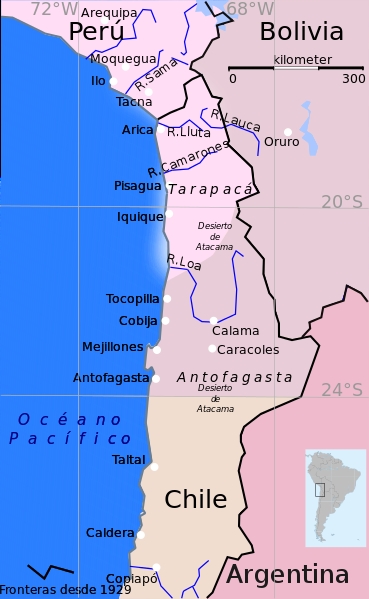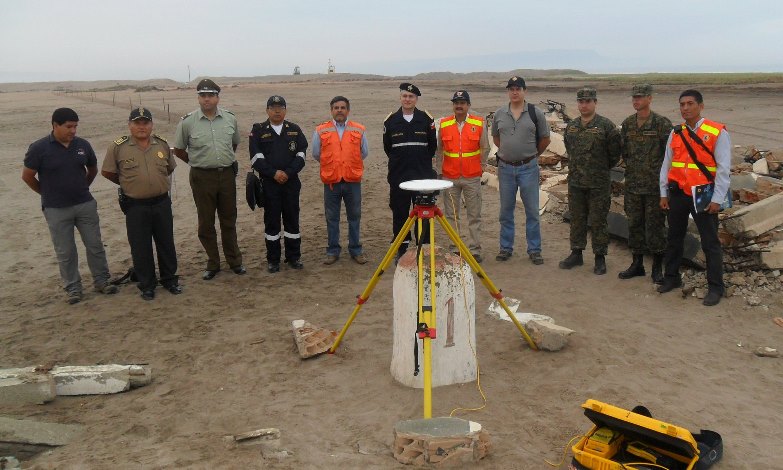Cassandra wrote a post about the landlocked Bolivian navy in which she explained, in passing, that Bolivia once had a coast but lost it to Chile in the War of the Pacific. One of the comments on that post, by guest poster Nick Suntzeff, was a post in itself and we thought you’d like to see it.
[Warning, my extended family is Chilean].
The 1880 War of the Pacific, which is essentially unknown here in the US, is still of vital interest in the Southern Cone. I think that a neutral version of the war would state that Bolivia imposed a tax on Chilean companies operating in Bolivia, in contradiction to a treaty between the countries. Chile protested, and Bolivia claimed that the dispute must be settled in Bolivian courts and not by international arbitration. Chile then claimed that the border treaty with Bolivia was therefore voided (a dubious claim), and sent troops to occupy Antofagasta. Unknown to Chile, Bolivia and Peru had signed a treaty in 1873 that the other country would come to its aid in case of war, bringing Peru into the fracas. Argentina was also in secret negotiation with Bolivia, being the eternal enemy of Chile, and while officially remaining neutral, did provide some scant aid to Bolivia and Peru. In return for not entering the war, Chile ceded the eastern part of Patagonia to Argentina.
With the occupation of Antofagasta by Chile, the war started, and I think to everyone’s surprise, including Chileans, Chile won the war. Peru and Bolivia were forced to sign a treaties (1904 and 1929) ceding land to Chile. The Chilean navy was trained by the the British Admiral Lord Cochrane which perhaps explains the victory, and to this day, all Chilean navy officers speak fluent English, wear British Admiralty uniforms, and secretly supported Britain in the Falklands War.
I lived in La Serena Chile for over 20 years, and the War of the Pacific, while known by all Chileans, had lost its primacy in their daily lives. In my city, there were reminders of the war – in one plaza are a series of rather treacly rococo statues stolen by the Chilean army from Lima and gifted to the city. Almost no one knows where they came from anymore, and they stand there, in uncomfortable corpulent alabaster poses from another century.
One local who did know where the statues came from joked to me that the statues were gifts from Peru when Chile “visited” – burned to the ground really – Lima during the war and gave the Peruvians the correct recipe for a pisco sour. Borders are important, but the history of pisco sours can even be more contentious in Chile and Peru. Never tell this joke in Lima.
 During the dark days of the Pinochet dictatorship, like all populist dictators Pinochet sought to find issues that would unite the country and make them forget the awful events going on in Chile. His government hit upon a clause in the 1883 Treaty of Ancón that stated that any land transfer from Chile to Peru and Bolivia must be approved by both countries. If you look at a map, you can see that the logical piece for Chile to give to Bolivia would be a strip of land at the northern border with Peru. However, the crafty Pinochet knew that he was giving a piece of land to Bolivia that once belonged to Peru. He could “innocently” say that his government was trying to give access to the sea to our friends in Bolivia, knowing full well that the piece of land that would be given to Bolivia was once Peruvian, and the Peruvians would never agree to giving up their previous territory. Pinochet could sit back and say that he a man of peace trying to find the best solution and look at these backward countries (Bolivia and Peru) – they are not trying to solve the problem. “We are willing to give up part of our country to solve the access to the sea problem for Bolivia” – but knowing full well that Peru would never agree to a strip of land at the northern border at “Hito 1” that was once theirs.
During the dark days of the Pinochet dictatorship, like all populist dictators Pinochet sought to find issues that would unite the country and make them forget the awful events going on in Chile. His government hit upon a clause in the 1883 Treaty of Ancón that stated that any land transfer from Chile to Peru and Bolivia must be approved by both countries. If you look at a map, you can see that the logical piece for Chile to give to Bolivia would be a strip of land at the northern border with Peru. However, the crafty Pinochet knew that he was giving a piece of land to Bolivia that once belonged to Peru. He could “innocently” say that his government was trying to give access to the sea to our friends in Bolivia, knowing full well that the piece of land that would be given to Bolivia was once Peruvian, and the Peruvians would never agree to giving up their previous territory. Pinochet could sit back and say that he a man of peace trying to find the best solution and look at these backward countries (Bolivia and Peru) – they are not trying to solve the problem. “We are willing to give up part of our country to solve the access to the sea problem for Bolivia” – but knowing full well that Peru would never agree to a strip of land at the northern border at “Hito 1” that was once theirs.
So that is where it stands. Bolivia has somehow convinced the World Court to hear their case, but it is almost impossible that the court will grant access to the sea to Bolivia by cutting what is now modern Chile into two pieces near Antofagasta. The logical thing to do is to give access at the north of Chile leaving Chile in one piece, something that Peru will never agree to.
Many years ago I visited Bolivia, which is a poor country, but a beautiful country rich in culture and humanity. Bolivians are wonderful people. I discovered, as did the [Cassandra Willyard], that the War of the Pacific is still a daily issue in Bolivia. But that was not on my mind. I love Andean music and some of the greatest Andean music comes from Bolivia. I wanted to buy a cassette of a folklore group called Los Kyarkas. (you should listen to their music – it is awesome). Having been in Bolivia for two weeks and learning that is not wise to mention that you live in Chile, I was amazed to see the Chilean group “Illapu” also sold in the music shop. Their song “Vuelvo” became the anthem of the return of democracy to Chile. It was the first Chilean thing I had seen in Bolivia. Sort of joking with the proprietor, I mentioned that I did not expect to see Chilean music sold in Bolivia. With absolutely no irony or amusement, he answered “They are not Chilean. They are from Antofagasta.”
The war was over 100 years ago, but it is still fresh in the minds of Bolivians, who passionately seek an exit to the sea, and the longing for the sea is in every Bolivian’s soul.
One final cultural footnote. Until I lived abroad, I never realized how important it is for the US to always be the “winner.” We define ourselves by our exceptionalism. We win all the wars. We have to be the best in everything. Donald Trump is a bitter distillation of this persona – never apologize, never stop bragging. When I lived in Australia, it took me a while to understand how a *defeat* – in WWI – could define the character of the country, because at Gallipoli, the Aussies discovered that there was a difference between being part of the empire and being British.
Similarly in Chile, they still celebrate the battle of Iquique, where the major naval battle between Chile and Peru was fought. And while the Chileans lost, this date is a national holiday. Arturo Prat, a Chilean naval commander, according to most naval historians, lost the battle because he did not take the Chilean fleet out to deep water, but kept them in the bay to fight, even though the Chilean fleet was not easily maneuverable in close quarters compared to the Peruvians. His bad naval judgement led to the defeat of the Chilean navy that day. Chileans even joke about this. There is a famous painting in Chile of Prat jumping onto the Peruvian ironclad Huáscar, looking over his shoulder holding his sword to the front as if telling his marines to follow him. Evidently few Chilean sailors did. Chileans with their characteristic irony, joke about the painting and say that what he was really saying was “Who pushed me??” It is refreshing to live in countries where even the stories of those who lost are an important part of the national character. Maybe we hunger for that too in the US, which is why there are so many Chicago Cubs fans.
___________
Nicholas Suntzeff is a professor of observational astronomy and a member of the Mitchell Institute for Fundamental Physics and Astronomy at Texas A&M University, where he heads the Astronomy Group inside the Department of Physics and Astronomy. He specializes in cosmology, supernova studies, and astronomical instrumentation. In fifth grade he received an Honorable Mention for turning his science project in on time.
___________
Hito #1 photo by Peruvian Ministerio de Relaciones Exteriores; the following caption by the author: This is a picture of “Hito 1” which means marker #1 in Spanish, under a theodolite stand. It denotes the border between Chile and Peru (sort of. They still always argue where it should be placed, but this is the present marker). I find it darkly humorous that this very humble marker represents the point of conflict between three countries – Chile, Peru, and Bolivia. It is located on the beach, in a demilitarized zone. This is the area that Chile, knowing full well that Peru will never accept it, is willing to donate to Bolivia.There is a carabinero (Chilean policeman) at the left in the light green shirt which is too tight. So Chilean!
map via Wikimedia Commons
